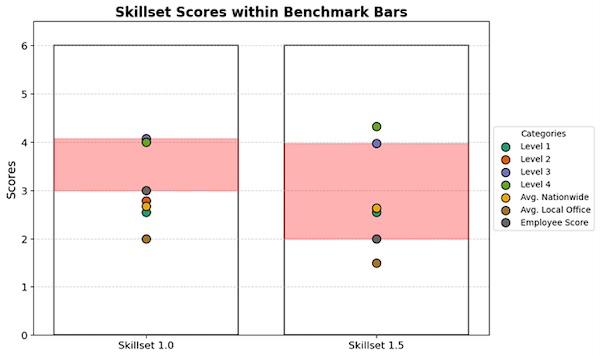Optimizing Workforce Resilience with Training
The renewable energy sector, characterized by rapid innovation and growth, necessitates a workforce that is both skilled and adaptable. One of the primary challenges in this dynamic industry is managing employee turnover while ensuring operational continuity. A key aspect of this challenge is the development and implementation of robust training programs.
In the context of renewable energy, where the technical landscape is constantly evolving, it becomes essential to equip new hires with necessary skills while mitigating the risk of 'single points of failure' within an organization. This phenomenon occurs when one or a few individuals are responsible for crucial tasks or hold unique knowledge which creates a vulnerability for the organization during turnover.

To counter this, renewable energy companies should initiate a comprehensive skill assessment and training program across the organization, focusing on the specific skills required in each role. This assessment can be conducted by evaluating employees' confidence in relevant skills and examining their ability to perform job-specific tasks. The goal is to amass a broad dataset that offers insights into skills distribution across different teams, offices, and hierarchical levels.
Once the skill landscape is mapped, it becomes clearer where the gaps are and how they can be addressed through targeted hiring or specialized training programs. This step is crucial for succession planning and ensuring that the organization's talent pool aligns with its strategic objectives.
The development of a high-functioning training program in the renewable energy sector should include:
Skill assessment and analysis
The first step to creating a high functioning training program is to assess the confidence of individuals within the organization. Self-confidence assessments or formal exams can be utilized to understand where each employee stands in terms of their technical and operational knowledge. Self-Confidence Ratings may have a lower certainty, but are much easier to develop than a formal exam which is comprehensive and accurately depicts the requirements of the role. Either of these methods can be built by reviewing job descriptions, perceived skill needs, and being reviewed by each level within the organization.
· Self-Confidence Assessment
This approach involves employees evaluating their own confidence levels for tasks pertinent to their role. While self-assessments may not always provide the most accurate measure of actual capability, they offer valuable insights into an employee's perceived strengths and areas of uncertainty. These perceptions are important for understanding how comfortable employees feel with their current roles and responsibilities, especially in a field as dynamic as renewable energy.
· Formal Examination
In contrast to self-assessments, formal exams provide a more objective measure of an employee's technical and operational knowledge. These exams are designed to thoroughly reflect the specific requirements of roles within the renewable energy sector. Although more resource-intensive to develop and implement, they offer a comprehensive understanding of an employee’s actual proficiency.
· SME Network
Once each personnel’s skillset confidence has been identified, organizations can also create an SME Network within the company to respond to urgent need for specialty knowledge. Additionally, the team of SMEs in each skillset can be polled for insight on the creation of training resources.
· Statistical Analysis
With statistical analysis, an organization can determine an individual’s confidence score in relation to other personnel in their career path, as well as determining how individual locations confidence compares to others. These insights provide a way to prioritize where we can backfill single points of failure and provide an intelligent approach to how training needs are prioritized.

Fig 1. In this figure, we can see where the technician’s confidence lies when compared to the rest of the organization. Being creative with the way data is visualized allows leaders and individuals to understand the near-term needs more easily as demonstrated with the red band getting taller. From there, you can tell where to target an individual’s training needs.
Training Plans
Apprenticeships and Structured OJT
Apprenticeships and Structured On-the-Job Training (OJT) are critical in creating a growth trajectory for entry-level employees, especially in specialized roles such as NETA Test Technicians. These programs offer a practical, hands-on approach to learning, allowing individuals to progressively acquire the skills necessary to advance through different certification levels.
Customized Training Plans
For more experienced individuals, they should have a customized training plan tailored to their specific needs and career trajectory. By using the data gathered from the skill assessments, training coordinators can design personalized learning paths. These plans would focus on areas where the individual has lower confidence, ensuring a well-rounded skill set upon completion that aligns with the rest of the organization’s needs.
Training Resource Types
Providing training resources is just as important as the structure of the program, and can be delivered in multiple ways. These are typically created by your training department with intensive support from your SME network; that SME network can be identified from your skills assessment.
 In-Person Training
In-Person Training
Interactive sessions such as workshops, seminars, and practical demonstrations are invaluable, especially for hands-on technical skills. These sessions not only enhance practical skills but also foster team collaboration and dynamics.
On-Demand Training
On-demand training resources, such as online courses, videos, and tutorials, offer flexibility and convenience. They are ideal for continuous learning and can be accessed anytime, anywhere. This approach supports self-paced learning and allows personnel to revisit materials as needed to reinforce their understanding. This is best created by dedicated training personnel that work directly with your SMEs to make content.
Just-in-Time Resources
Just-in-time training resources, like quick reference guides, FAQs, and troubleshooting manuals, are essential for immediate problem-solving and skill application in the workplace. These resources are particularly useful for addressing specific challenges as they arise, providing personnel with the information they need exactly when they need it.
Overall, assessing your organization’s skills and creating a complementary training program with these methods can help break down organizational information silo’s while increasing your team’s operational resilience.
Ben Clark is an accomplished Director of Technical Development at RESA Power, specializing in Power Systems with a focus on Power Transformers, Protection & Control (P&C), Commissioning, Maintenance, and Engineering.
RESA Power | www.resapower.com
Author: Ben Clark
Volume: 2024 March/April









.jpg?r=2301)

.gif?r=6723)
.jpg?r=4690)